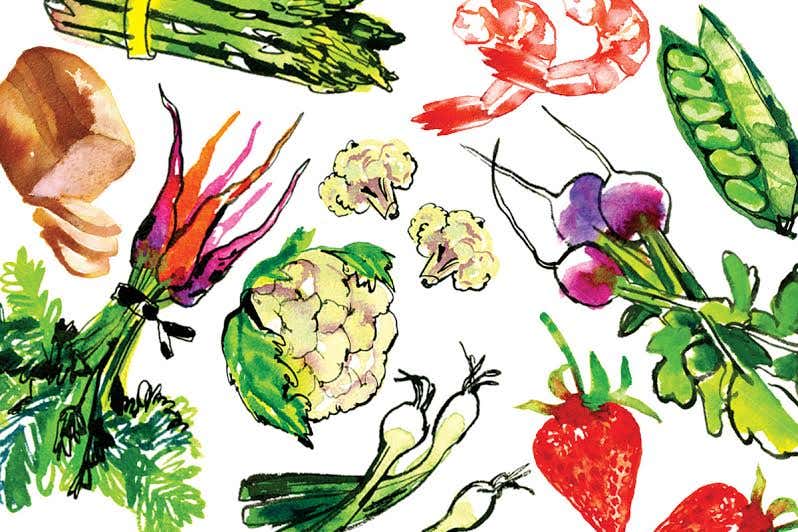
**SAKIZUKE **_Appetizer (saki=ahead; zuke=set). Fuyofu Tara Kuzutataki (Clear Soup with Codfish and Soft Roe) _In traditional kaiseki, this course is the heart of the dinner: Early tea ceremonies consisted of simply a soup and three side dishes. Because of its simplicity, wanmori is still considered the most critical measure of the chef's skill. In winter, Takanashi's soup features cod and its roe, and winter ingredients signifying spring: a paper-thin disk of daikon, a chrysanthemum leaf, and the rind of yuzu, a citrus fruit, classically matsubagiri-cut (in the shape of a pine needle).
**CHINMI **_Delicacy (chin=rare; mi=taste). Ginnan Awabu Shiraae (Ginkgo Nut and Wheat Gluten Salad with Tofu Dressing) _Although there are many courses in the kaiseki progression, it is not a filling meal: Portions are not much larger than bite-size morsels (and nothing should be left on the plate). Takanashi serves a mere spoonful of this salad made of awabu (a type of wheat gluten), and ginkgo nuts, which are subtle in flavor but heavy in symbolism (seeds, in Japan, are associated with birth and life), dressed with whipped tofu, sesame paste, sugar, and niban-dashi.
WANMORI Soup (wan=bowl; mori=to pile up). Kumokodofu Tara Kuzutataki (Clear Soup with Codfish and Soft Roe) In traditional kaiseki, this course is the heart of the dinner: Early tea ceremonies consisted of simply a soup and three side dishes. Because of its simplicity, wanmori is still considered the most critical measure of the chef's skill. In winter, Takanashi's soup features cod and its roe, and winter ingredients signifying spring: a paper-thin disk of daikon, a chrysanthemum leaf, and the rind of yuzu, a citrus fruit, classically matsubagiri-cut (in the shape of a pine needle).
**MUKÔZUKE **_Appetizer (muko= beyond; zuke=set). Sashimi (Assorted Raw Tuna, Flounder, and Squid) _The name mukozuke refers to the positioning of the sashimi dish relative to two other dishes—one rice, one soup—which, in traditional kaiseki dinners, are presented at the same time. Takanashi serves sashimi on its own, but always early in the meal, before the palate is sated with cooked foods. Freshness dictates what fish appear on the plate: perhaps flounder and tuna in winter; shrimp and sea bream in spring; abalone and sea bass in summer; bream and mackerel in autumn.
**TAKIAWASE **_Simmered Dish (taki=to simmer; awase=mix). Ebiimo Kofu Shiitake Hijiki (Taro, Tofu, Mushroom, Seaweed) _In theory, the kaiseki progression should include a wide variety of ingredients that incorporate foods from the mountains, fields, forests, rivers, and oceans. Most Japanese chefs today are not so orthodox, but they still strive to balance ingredients from the land with those from the sea. Takanashi builds a landscape in this vegetarian dish, with a cube of tofu as a mountain in the rear, eclipsing carved taro, a single shiitake, and a nest of hijiki.
**MUSHIMONO **Steamed Dish (mushi=steamed; mono=things). Kaki Joyo-mushi Tororoimo Bekkoankake (Oyster and Mountain Potato with Sauce) Even in modern Japanese cooking, garnishes are more than arbitrary decorations. Whether they be beans, leaves, nuts, shoots, fruit, or sauces, they are chosen for what they symbolize, for their flavor, and for their ability to bring out the best in a dish. Here, Takanashi uses a tortoiseshell-colored sauce (bekko means tortoiseshell) of dashi, mirin, and soy sauce to float a steamed oyster topped with grated mountain potato.
**YAKIMONO **_Grilled Dish (yaki=grilled; mono=things). Amadai Wakasa-yaki (Grilled Red Tilefish) _In the early years of kaiseki, yakimono, the grilled course, was created as a practical way to use up any food remaining from the preparation of previous courses. Therefore, to counter the shabbiness of what were technically ''leftovers'', this course would always be presented on the most elaborate, dignified tableware. The ''leftover'' connotation disappeared at the turn of the century, but Takanashi still chooses to place his grilled fish—in this menu he uses amadai—on exquisite handmade pottery.
**SUNOMONO **Vinegared Dish (su=vinegar; mono=things). Kani Wakame-maki Shonomono (Crab Wrapped in Wakame Seaweed) Formal Japanese meals have a definite beginning and end. Sunomono is not mandatory but is added to more elaborate banquets. Its purpose is to refresh the palate either early on as an appetizer, between courses, or, as in Taka-nashi's progression, just before the rice course. This ''salad'' should be prepared just before it is to be served. An aromatic garnish—in this case, mitsuba (trefoil, a type of clover)—is considered essential as a balance to the vinegar.
TOMEWAN Final Dish _(tome=stop; wan=bowl). Jako-Gohan, Akadashi, (Anchovy Rice with Miso Soup and Pickles) _Rice was a measure of economic and political power in Japan from the seventh through the mid-19th century. This precious grain appears in the kaiseki progression only at the end, though, because kaiseki is a meal to be taken while sipping sake—and it is not customary to eat rice with sake, itself made from fermented rice. Takanashi enhances his rice dish with jako (tiny dried anchovies), and offers it with miso soup and cabbage pickles.
**
Keep Reading
Continue to Next Story










